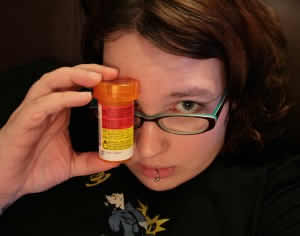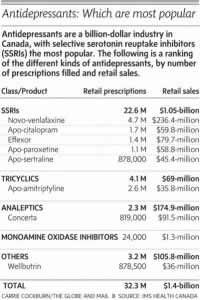Loaded on Pills
How North America Is Losing Its War Against Depression

Via me and the sysop, flickr
By: Jorge T. Armand, Staff Writer
Twitter: Jorge__Armand
Smiling sparse teeth, he looked up in victory over the pool table, with a shaved head, black framed glasses, silver earrings, and a tattooed arm that read ’Product of Influence. That’s how Blaze Convict and I met; I later found out his name is Blaise Convey.
One hot summer afternoon, we were sucking on beers. The phone rang. Blaise got up and answered it; then, silence. His brother had just jumped off of the MacDonald bridge in Halifax, Nova Scotia.
The suicide of Patrick Convey, a major influence in his life, plunged Blaise into a massive depression. Diagnosed with Post Traumatic Stress disorder (PTSD), Blaise was prescribed Paroxetine, an antidepressant commonly known as Paxil.
Launched in 1992 by the pharmaceutical company SmithKline Beecham, now GlaxoSmithKline (GSK), Paxil is used to treat major depression, obsessive compulsive disorder, and anxiety.
On October 16, 2009, The Globe and Mail reported that the most popular antidepressants in Canada are selective reuptake inhibitors (SSRIs). Best known under brand names like Paxil, Prozac, and Zoloft, these drugs excite the brain by releasing serotonin, a neurotransmitter that contributes to feelings of well-being. Paxil is the most potent of these drugs and has the shortest half-life of those in the the SSRIs family.
According to IMS Health Canada, a private company that tracks prescription drug sales, 22.6 million prescriptions for SSRIs were made in 2008, generating a total of $1.05 billion for pharmaceutical companies.
Like thousands of other Paxil users, Blaise reacted terribly to the effects of the drug. Bringing his hands to his forehead, he laments, ’I can barely remember what was going through my mind, mostly because I was completely blank or numb. I wasn’t able to feel a goddamn thing besides fear.
Dr. Srinivasan Pillay is a world-renowned expert in stress and anxiety, Clinical Professor of Psychiatry at Harvard Medical School, and the award-winning author of ’Life Unlocked: 7 Revolutionary Lessons to Overcome Fear. He believes that ’a good physician is always uncomfortable when someone is under medication and never overestimates how much is known about a drug.
Paxil is known to have side effects including, but not limited to: sexual dysfunction, insomnia, sedation, headaches, suicidal thoughts, and an increase in birth defects. Wait, most drugs are said to have some side effects, right? Frighteningly enough, however, it gets worse – the minute you decide to stop taking Paxil.
Back in 1999, when the internet was somewhat primitive, there was no information available about Paxil’s severe withdrawal process. Even within the medical community, little about this issue was well known. One man, who ’couldn’t sleep anyways, due to his Paxil withdrawal symptoms, decided to change that.

Frank Streicher created Quitpaxil.org, the first ever website to assist Paxil users experiencing withdrawal symptoms. The site gathers all available information on the subject of Paxil withdrawal and features an ongoing blog that discusses users experiences with the drug. I was really quite astounded at how quickly it all happened; within weeks, I was inundated with hundreds of letters. At one point, I was getting a hundred letters a day. I mean, it was really just insane. I had to build a bigger website, Frank recalls.
Following the guidelines of Quitpaxil.org, Blaise began to carefully reduce his Paxil dosage. When he finally stopped taking it completely, all hell broke loose. ’Physically, it was almost equally as bad as the acute alcohol withdrawal I experienced after my brother’s death. I went through things like brain zaps, panic attacks, and upset stomach. But the worst part was definitely the psychological effects. I was unsure of my own existence; everything looked two dimensional. It’s called depersonalization. I had a constant, intense fear that I could never explain, remembers Blaise.
You might be wondering why a drug like Paxil ever made the market, or why it’s still so popular. In 1988, before Paxil was officially on the market, GSK (formerly Smith Kline Beecham) conducted a clinical Paxil test in Yugoslavia; however, what happened in Yugoslavia was never exposed to the public eye.
The trial consisted of participants suffering from major depressive disorders. The trial was divided into two phases: in phase one, all patients took Paxil. In phase two, patients were randomized into two groups, one of which remained on Paxil while the other was given a placebo.
Following phase two, the placebo patients began experiencing massive Paxil withdrawal symptoms. As a result, these patients entered a depressive state that was far worse than their initial one. On August 14, 2001, in The Superior Court of the State of California case, Lacuzong vs SKB, it was argued that the Yugoslavia trials weren’t intended to seek withdrawal symptoms; the patients, rather, were simply seen as suffering a relapse.
In 1992, Paxil was launched with no withdrawal warnings. As Dr. Pillay recalls, ’When we first started prescribing these drugs, you would get a pharmaceutical representative bringing you pens, books, offering tickets to things. He also argues that recent studies show that repeated exposure to a certain name may cause an unconscious bias in consumers.
Contrary to Canadian direct-to-consumer drug advertising restrictions, media outlets in the US are infested with prescription medicine ads that barely slur the side effects of these drugs.
Dr. David Reiss, who has performed more than 10,000 psychiatric evaluations, says he stopped seeing pharmaceutical representatives twenty years ago. He asserts, Half of what they said, you couldn’t have faith in. These days, I’ll go to presentations and pick up some of the literature, but even with that, you have to be careful. They are trained to sell, and I’m not there to buy. Further, he alleges that ’There’s a lot of pressure to basically sedate people or get them drugged to suppress symptoms and not really deal with what’s going on.
These days, it seems relatively easy to get a hold of these drugs, or even to feel like you might need them. Amanda Clark, former Paxil user and certified Peer Specialist at the Assertive Community Recovery LLC in Georgia, says she has been to over nine doctors in the past year. According to her, ’a lot of doctors are pill pushers.
One of Amanda’s doctors prescribed her Paxil after a rapid consultation. Amanda experienced vomiting, total loss of hair, night-sweats, intense nightmares, and extreme sensitivity to sunlight. ’It took me three months to feel normal again…I would say it’s up there with getting off anti-psychotics, says Amanda.
Advertisements promise you won’t mind the extra forty pounds, that the love of your life won’t mind your sexual shortcomings, and that you won’t kill yourself?á’ you might be too sedated. On top of that, the average doctor might be ready to spray his antidepressant candy shotgun all over the consultation room. Once you’ve experienced all this, and when you no longer feel like walking over to the pharmacy to get more pills, you can have it brought right to your door!
In the United States, you can send your prescription to Medco Health Solutions, a company that serves the needs of more than 65 million people, and have antidepressants delivered. Medco made more than $59.8 billion in 2009 ’ that’s more than three times the total GDP of Nicaragua. Medco refused to disclose specifics about the revenue made from antidepressant sales.
Dr. David Muzina, National Practice Leader for Medco’s Neuroscience Therapeutic Resource Center, says Medco’s claim records detect when someone falls off therapy or compliance with medication. A highly trained pharmacist may reach out to the patient and begin a consultation over the phone.
Dr. Muzina says antidepressant medication strategies should be looked at carefully. The prescription of a one year long antidepressant supply is a common mistake. After one starts antidepressant therapy, doctors should schedule about 7 follow-up appointments with the patient. Dr. Muzina explains, ’Unfortunately, a minority of patients actually see their prescribing physician at the required frequency after they start an antidepressant, I think that’s a critical mistake made by many clinicians.
Anyone who suffers from mental illness or from damage caused by medication should be made aware by doctors that there are other approaches to treatment. Dr. Pillay encourages broader and more flexible ways of thinking. He wonders, ’Should we not be aware of not falling into the trap of just explaining every life event as a mental illness? I always discourage people from looking at themselves through the lens of their diagnosis. It’s really important to realize that the picture of yourself extends far beyond your specific vulnerabilities. It is important to encourage people to not limit their identity by looking at themselves through the lens of mental illness.































Share the post "Loaded on Pills"